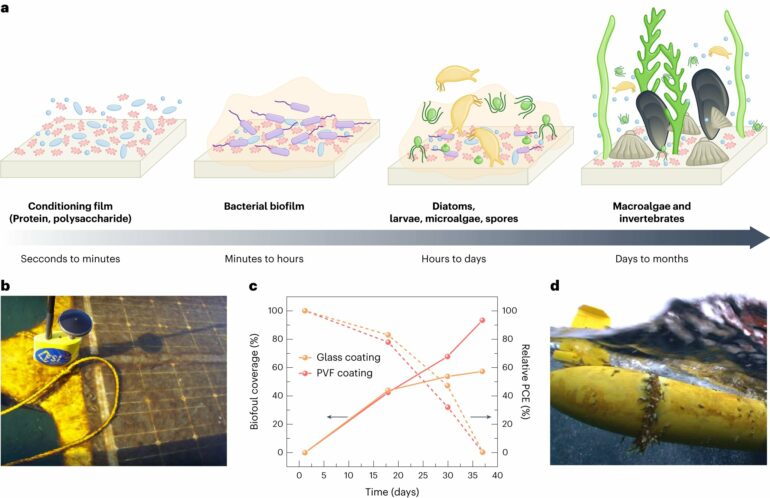From the days when mapmakers drew dragons and sea monsters at the margins of the explored seas, the oceans have always offered unexplored mysteries. Centuries on, we have made surprisingly little progress—only around 5% of the world’s oceans have been mapped.
Autonomous underwater vehicles (AUVs) and remotely operated underwater vehicles (ROUVs) may help us explore deeper and further than before, but then you run into another problem—power.
The major obstacle lies in the short power cycles of batteries and the absence of persistent onboard power sources. To overcome these challenges, researchers are focused on developing alternative power solutions that enable AUVs and ROUVs to operate without constraints on diving patterns or the need for resurfacing to recharge. Additionally, the aim is to create power sources for fixed underwater sensors and communication networks that do not solely rely on batteries or require a physical tether for power supply.
Solar power is a potential solution—sunlight can penetrate surprisingly deeply into the oceans. If that energy can be harnessed, it’s only a matter of converting it, and a group of researchers from NYU Tandon are exploring how to make solar power viable for underwater vehicles.
In a new article in Nature Photonics called “A dive into underwater solar cells,” a team including Jason A. Röhr and André Taylor from the Department of Chemical and Biomolecular Engineering lay out the problems faced by this burgeoning field.
While marine power technologies utilizing waves, tides, ocean currents, and osmotic forces exhibit some potential, they are location dependent and lack portability. One exception stands out—oceanic thermal energy conversion (OTEC), which harnesses temperature gradients between the sea’s surface and deeper waters. Although OTEC has been successfully used to power AUVs for extended periods, its reliance on specific diving patterns and limited applicability to tropical and subtropical regions inhibits the implementation of fixed underwater devices.
Solar power, just as on land, is ubiquitous, available, and powerful, even below the surface. Sunlight remains consistent and can be harnessed efficiently. Visible light, particularly in the green to blue part of the spectrum, can penetrate waters up to 50 meters deep, providing sufficient energy to run basic appliances.
By utilizing solar cells, it becomes possible to power fixed sensors, communication devices, and even combine solar power with OTEC for long-range AUV operations and true autonomy. But the solar cells we currently use may not be up to snuff.
The researchers delved into the potential of solar cells for underwater applications, highlighting examples of successful implementation in powering AUVs and communication devices while analyzing the downsides. Specifically, they identified key ways that common silicon solar technology falls short in underwater environments— beyond moisture and salt content, enemies to electronics in general, solar cells are designed to absorb red and infrared light, pieces of the spectrum that do not penetrate very far into water.
Alternative technologies like gallium indium phosphide (GaInP) and cadmium telluride (CdTe), have demonstrated higher efficiency and the potential for optimization in the specific conditions of ocean water. Next-generation solar cells such as organic and perovskite solar cells (OSCs and PSCs) are also being considered.
Finding the perfect absorber material is only one of the major issues underwater solar cells face. Biofouling, the gradual accumulation of organic substances comprising microorganisms, plants, and diminutive animals, presents a formidable challenge to various marine technologies, particularly those operating in shallower oceanic domains.
This crust of organic matter decreases the solar cell’s light access, impeding the photovoltaic process and its subsequent performance. Moreover, the encumbrance extends to the submerged vehicles themselves, where matter accumulates on their hulls, augmenting weight and generating hydrodynamic resistance. In previous experiments, befouling covered more than 50 percent of the surface after only 30 days underwater, which would hamper the ability of solar cells to operate.
In the paper, the researchers also discuss practical issues in designing and testing such solar cells. While NYU Tandon is only a subway ride away from the ocean, institutions without water access can’t test any potential designs easily—and live testing solar cells and batteries with potentially dangerous materials would be inadvisable anyway.
One solution the researchers came up with was to use LED lights to simulate the light spectrum available at different depths, without the need for water at all. Doing so, they showed that silicon based solar cells outperformed the competition at shallow depths, but other cells were more efficient at anything below two meters. The researchers note a few other options for testing as well.
While these new solar cells, specifically tuned for aquatic environments, are only at the very early stages of development, the researchers’ contributions could lay the groundwork for technologies that could illuminate our understanding of both solar energy and the unexplored seas that have tempted humanity since we first set sail.
More information:
Jason A. Röhr et al, A dive into underwater solar cells, Nature Photonics (2023). DOI: 10.1038/s41566-023-01276-z
Provided by
NYU Tandon School of Engineering
Citation:
Under the sea: Can solar-powered underwater vehicles help us better understand our oceans? (2023, September 1)



